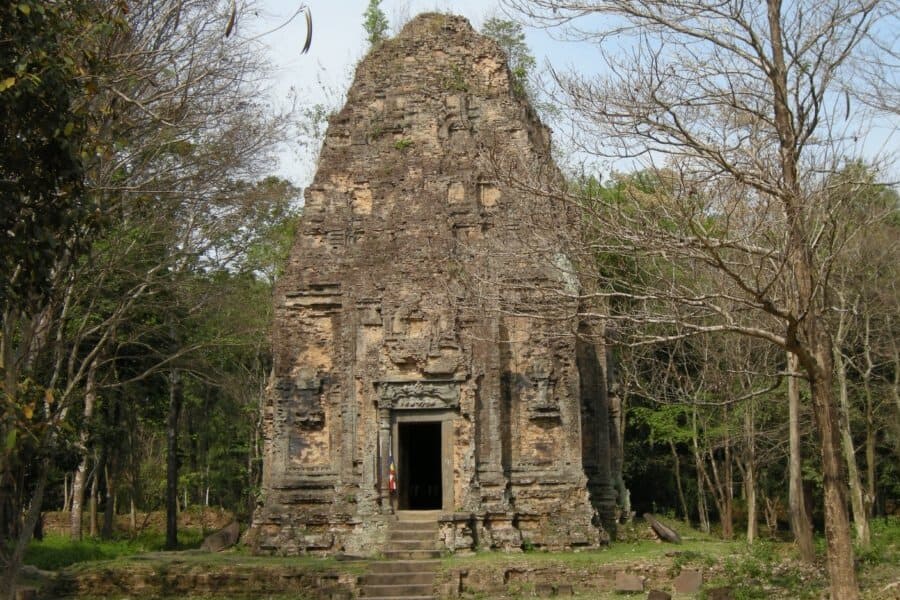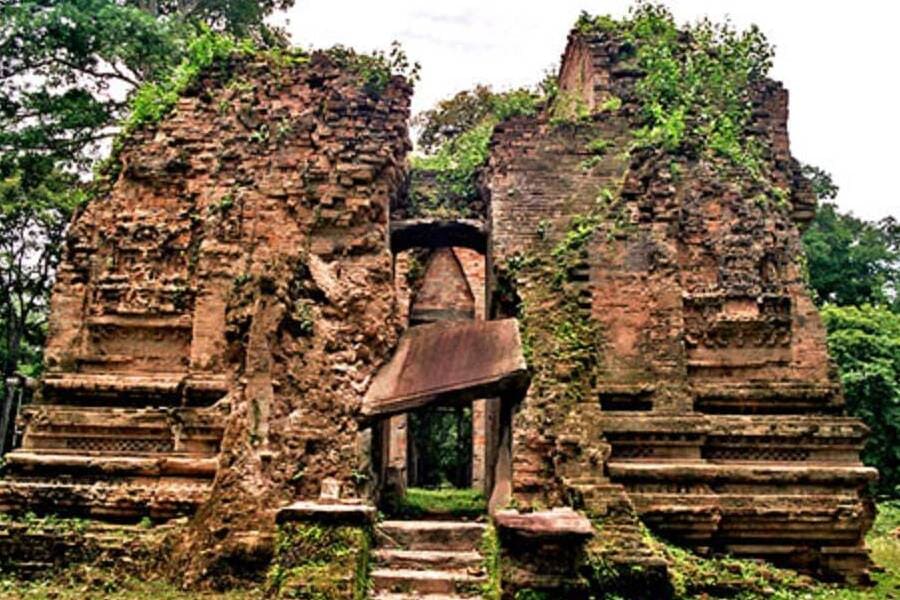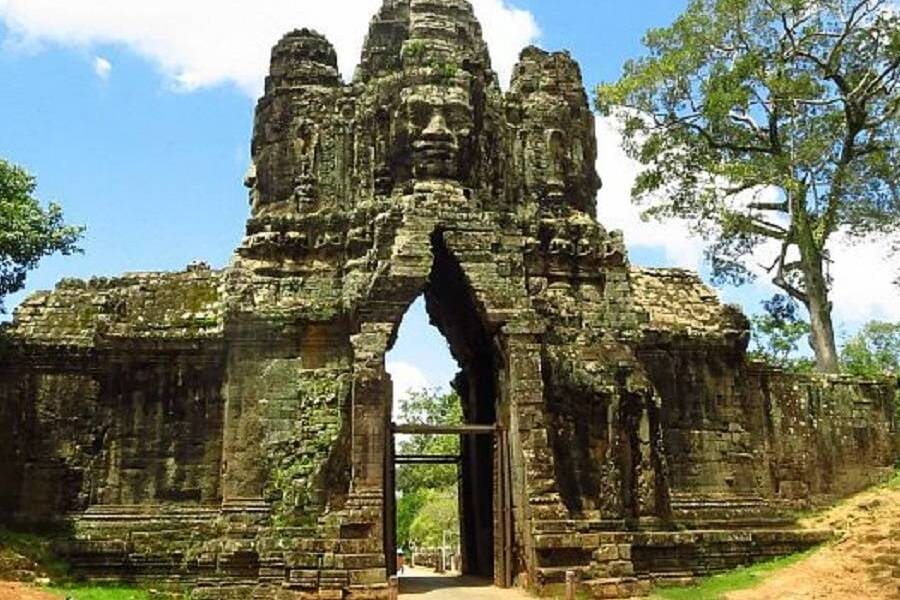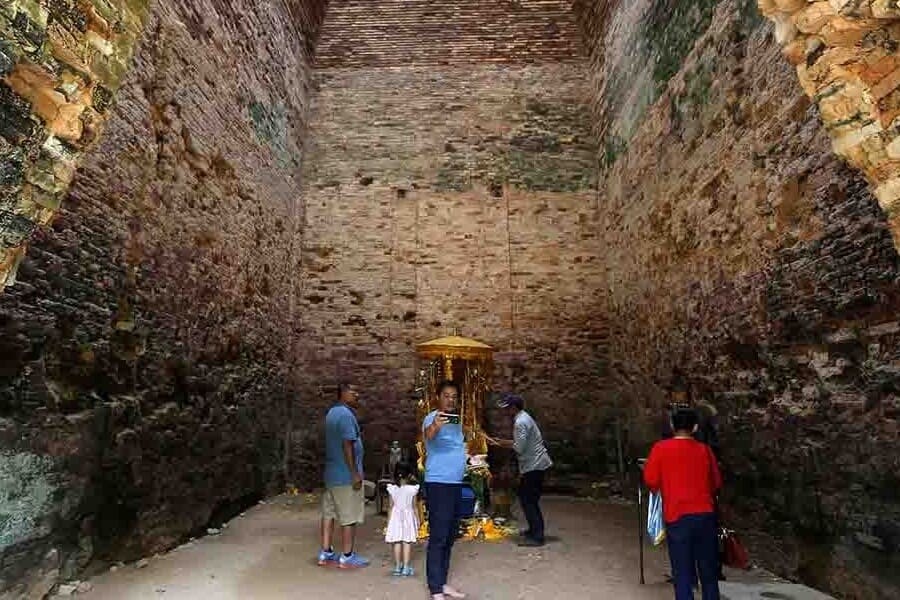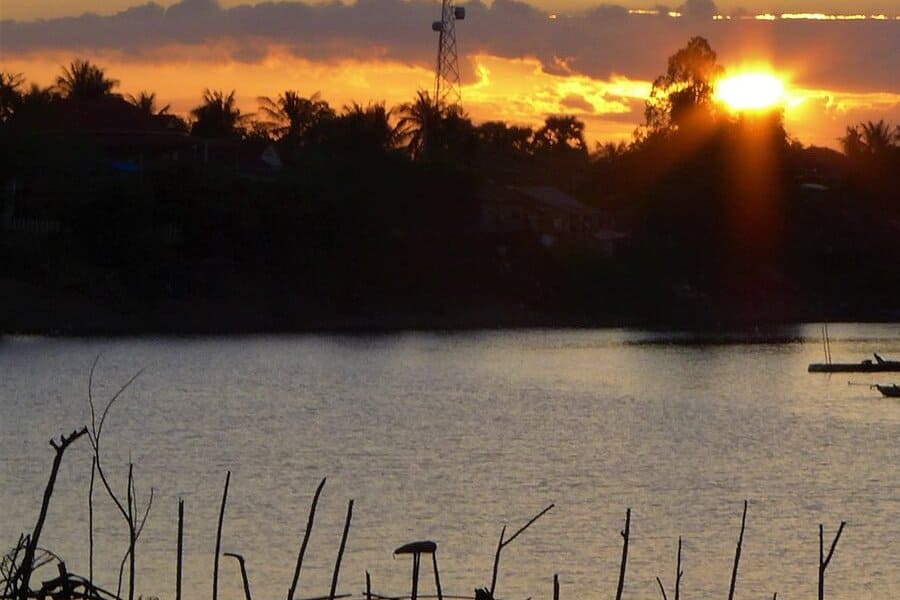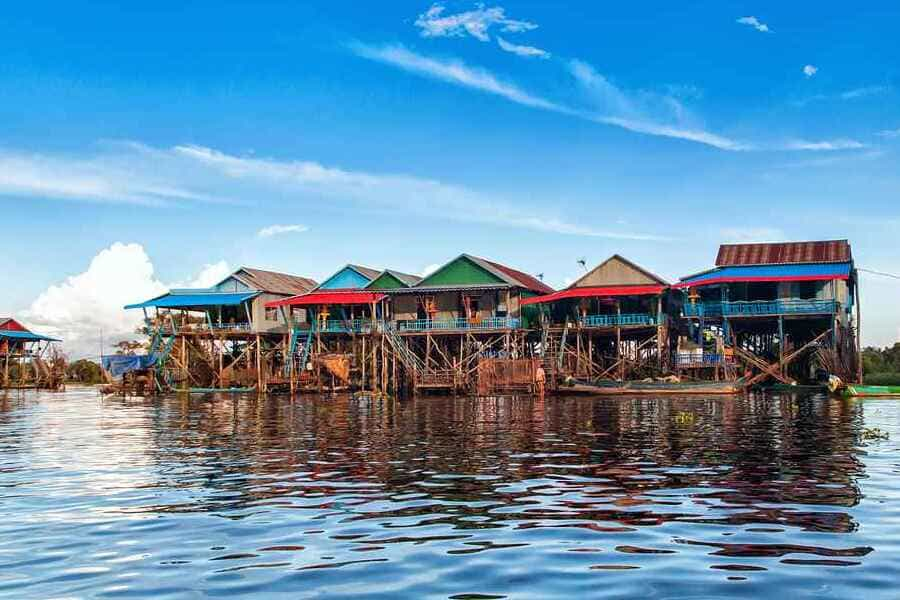Embark on a journey through time and heritage as we delve into the enchanting realm of Sambor Prei Kuk, a pre-Angkorian temple complex nestled amidst the lush Cambodian forest. As part of your Cambodia trips, prepare to be captivated by the ancient allure of this hidden gem, where centuries-old ruins whisper tales of bygone civilizations and architectural wonders that stand as testament to Cambodia's rich cultural legacy.
Contents
History and Origins Sambor Prei Kuk Temple
Sambor Prei Kuk, located in present-day Kampong Thom province, Cambodia, holds a rich history dating back to the Chenla period, which spanned from the late 6th century to the early 9th century CE. During this time, the Chenla Kingdom emerged as a powerful polity in mainland Southeast Asia, preceding the Angkorian Empire.
The temple complex of Sambor Prei Kuk was constructed during the reign of Isanavarman I, a Chenla king who ruled from 616 to 635 CE. Originally known as Isanapura, the site served as the capital of the Chenla Kingdom and was a center of political, economic, and religious activity.
The temples of Sambor Prei Kuk were dedicated to the Hindu god Shiva, reflecting the predominant religious beliefs of the Chenla period. These temples served as places of worship, pilgrimage, and royal patronage, with intricate carvings and sculptures depicting scenes from Hindu mythology adorning their sandstone walls.
Following the decline of the Chenla Kingdom, Sambor Prei Kuk fell into obscurity and was gradually reclaimed by the surrounding forest. It was not until the late 19th century that the site was rediscovered by French archaeologists, who recognized its historical significance and undertook restoration efforts to preserve its architectural heritage.
Today, Sambor Prei Kuk stands as a UNESCO World Heritage Site and a testament to Cambodia's ancient civilization. Its well-preserved temples and intricate carvings offer valuable insights into the art, architecture, and religious practices of the Chenla period, contributing to our understanding of Cambodia's cultural heritage and historical development. As one of the earliest temple complexes in the country, Sambor Prei Kuk holds a special place in Cambodia's history and remains a revered site of pilgrimage and exploration for visitors from around the world.
Architecture and Design of Sambor Prei Kuk Temple
The architecture and design of Sambor Prei Kuk temple complex are a testament to the ingenuity and craftsmanship of the Khmer builders during the Chenla period. Here are some key features of the architecture and design:
Compact and Modest Structures: Unlike the grandeur of later Angkorian temples, the temples of Sambor Prei Kuk are characterized by their compact and modest size. The temples typically consist of single-chambered structures, with some featuring additional antechambers or vestibules.
Sandstone Construction: The temples of Sambor Prei Kuk were constructed primarily using sandstone, a readily available material in the region. The sandstone blocks were quarried locally and intricately carved with decorative motifs, lintels, and bas-reliefs.
Octagonal and Cruciform Prasats: One of the unique architectural features of Sambor Prei Kuk is its octagonal and cruciform-shaped prasats, or towers. These towers stand atop raised platforms and are adorned with intricate carvings depicting deities, mythological scenes, and celestial beings.
Mandala-like Layout: The temple complex is laid out in a series of concentric circles connected by long avenues, creating a mandala-like pattern. This architectural layout reflects the cosmological and spiritual beliefs of the time, with each temple serving as a symbolic representation of the universe and its divine order.
Decorative Elements: The temples of Sambor Prei Kuk are adorned with elaborate decorative elements, including intricately carved lintels, pediments, and door frames. These carvings depict scenes from Hindu mythology, such as the churning of the ocean of milk, the epic battles of gods and demons, and the life stories of deities like Shiva and Vishnu.
Baray and Reservoirs: Surrounding the temple complex are several man-made water features, including barays (reservoirs) and ponds. These water features served both practical and symbolic purposes, providing irrigation for agricultural purposes and serving as sacred bodies of water for religious rituals and ceremonies.
The Cultural and Religious significance of Sambor Prei Kuk Temple
Sambor Prei Kuk temple complex holds profound cultural and religious significance as a sacred site dedicated to Hindu worship during the Chenla period.
- Hindu Devotion: The temples of Sambor Prei Kuk were dedicated to the Hindu god Shiva, one of the principal deities in Hinduism. As centers of worship, pilgrimage, and royal patronage, these temples played a vital role in religious life and spiritual practice during the Chenla period.
- Sacred Pilgrimage Site: Sambor Prei Kuk served as a sacred pilgrimage site for devotees who traveled from far and wide to pay homage to the gods and seek blessings for prosperity, fertility, and protection. Pilgrims would participate in rituals, make offerings, and seek divine guidance from the temple priests.
- Cultural Exchange: The temple complex of Sambor Prei Kuk reflects the cultural exchange and religious syncretism that characterized the Chenla period. While dedicated to Hindu worship, the temples also feature elements of Buddhist symbolism and iconography, indicating the coexistence and integration of diverse religious beliefs and practices.
- Royal Patronage: The construction and maintenance of Sambor Prei Kuk were supported by royal patronage, with Chenla kings overseeing the building of temples and the performance of religious rituals. The temples served as symbols of royal power and authority, reinforcing the divine right of kingship and legitimizing the rulers' connections to the gods.
- Cosmic Symbolism: The architectural layout and design of Sambor Prei Kuk reflect cosmic symbolism and spiritual beliefs, with each temple representing a symbolic representation of the universe and its divine order. The mandala-like layout of concentric circles and the alignment of temples along cardinal directions underscored the temple complex's connection to cosmological principles.
- Cultural Heritage: As one of the earliest temple sites in Cambodia, Sambor Prei Kuk holds immense cultural heritage significance, providing valuable insights into the art, architecture, and religious practices of the Chenla period. Its well-preserved temples and intricate carvings serve as tangible links to Cambodia's ancient past and contribute to our understanding of the country's cultural identity and historical development.
Practical tips and advice for visitors planning to explore Sambor Prei Kuk Temple
Transportation options
Sambor Prei Kuk is located approximately 30 kilometers north of the town of Kampong Thom in Cambodia. Visitors can reach the temple complex by various transportation options, including:
- Private car or taxi: Renting a private car or hiring a taxi is the most convenient option for reaching Sambor Prei Kuk. This allows for flexibility in timing and stops along the way.
- Tuk-tuk: Tuk-tuks are a popular mode of transportation in Cambodia and can be hired for a half-day or full-day trip to Sambor Prei Kuk from Kampong Thom or nearby towns.
- Motorbike rental: Adventurous travelers may opt to rent a motorbike to explore the countryside and reach Sambor Prei Kuk independently. However, road conditions may vary, so exercise caution while riding.
Entrance fees
The entrance fee to Sambor Prei Kuk temple complex is around $10 USD per person for foreign tourists.
Recommended activities
- Guided Tour: Consider hiring a local guide at the entrance to Sambor Prei Kuk to provide insights into the history, architecture, and significance of the temple complex. Guides can enhance your understanding of the site and help navigate the maze of temples.
- Exploring the Temples: Take your time to explore the various temples and structures within Sambor Prei Kuk at your own pace. Admire the intricate carvings, bas-reliefs, and architectural features that adorn the sandstone structures.
- Photography: Sambor Prei Kuk offers plenty of opportunities for photography enthusiasts to capture the beauty and tranquility of the ancient temples amidst the forest backdrop. Remember to respect any signage or guidelines regarding photography restrictions.
- Nature Walks: Take advantage of the scenic trails and pathways that wind through the forest surrounding Sambor Prei Kuk. Nature walks offer a chance to appreciate the natural beauty of the area and perhaps encounter wildlife such as birds and monkeys.
Sambor Prei Kuk Temple Nearby Attractions
While visiting Sambor Prei Kuk temple complex, travelers have the opportunity to explore several nearby attractions and points of interest. Here are some notable places to visit in the vicinity:
Kampong Thom
The provincial capital of Kampong Thom offers a range of attractions, including bustling markets, historic sites, and cultural landmarks. Visitors can explore the local cuisine, shop for handicrafts, and visit nearby temples such as Prasat Andet and Prasat Kok Rokar.
Stung Sen River
The Stung Sen River flows near Sambor Prei Kuk temple complex, offering opportunities for scenic boat rides and river cruises. Travelers can enjoy peaceful moments along the riverbanks, observe local life, and spot birdlife and wildlife in the surrounding wetlands.
Prasat Sambor
Located a short distance from Sambor Prei Kuk, Prasat Sambor is another ancient temple site dating back to the Chenla period. While smaller in scale compared to Sambor Prei Kuk, Prasat Sambor features well-preserved sandstone temples and offers insights into the region's archaeological heritage.
Phnom Santuk
A sacred hill located southwest of Kampong Thom, Phnom Santuk is a pilgrimage site known for its hilltop pagoda and panoramic views of the surrounding countryside. Visitors can climb the stairs to the hilltop shrine, explore the temple complex, and enjoy the tranquil atmosphere amidst lush greenery.
Tonle Sap Lake
For those interested in exploring Cambodia's natural beauty, a visit to Tonle Sap Lake is highly recommended. The largest freshwater lake in Southeast Asia, Tonle Sap is home to floating villages, diverse ecosystems, and vibrant birdlife. Travelers can take boat tours to explore the lake's picturesque landscapes and learn about local fishing communities.
Preah Khan Kompong Svay
Located approximately 100 kilometers northeast of Sambor Prei Kuk, Preah Khan Kompong Svay is a sprawling temple complex dating back to the Angkorian era. This remote and lesser-known site features impressive temple ruins, including a massive central sanctuary and extensive galleries adorned with intricate carvings.
In conclusion, Sambor Prei Kuk stands as a mesmerizing testament to Cambodia's ancient past, offering a captivating glimpse into the country's pre-Angkorian heritage. Nestled amidst a tranquil forest, this temple complex exudes an aura of mystery and grandeur, beckoning travelers on a journey through time and culture.

